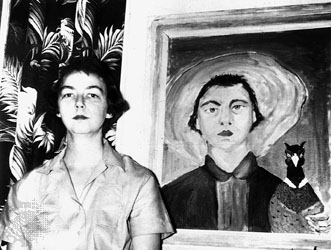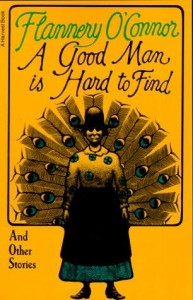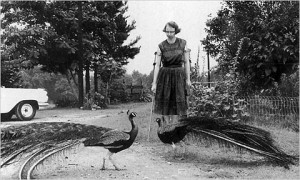A few years ago I paid tribute to Flannery O’Connor on the occasion of a new biography (that I still need to read).
Here it is, revisited, with a bonus surprise at the end…
Of few writers can it more accurately be said that it is the work, not the life, that matters…That O’Connor was one of the great writers of the 20th century is now beyond argument.
What he said. He being Jonathan Yardley, writing in Sunday’s Washington Post (farewell Book World, hello expanded Arts & Living section) about Brad Gooch’s new bio of Flannery O’Connor here.
While I’m not certain that we need a 448 page biography of Flannery O’Connor, I’m not certain that we need another biography of any writer, no matter how many pages. Actually, that’s not fair. Who buys these types of books, after all, but people who have already read all (or most) of the works written by the author being dissected (this crucible that is equal parts operating table and shrink’s couch, also known as the contemporary critical biography). Still, I could probably be forgiven for making the unoriginal observation, again, that we exist in an era where the life outweighs the work. That cranky ground was well-trodden upon, and recently, so no need to revisit it.
Wait. The preceding paragraph, while applicable to most writers, does not apply to O’Connor. In point of fact, if there is any writer I would care to read about, and learn from, it would be her. Not surprisingly, her unwavering allegiance to her craft leaves little to the imagination: she wrote, she talked about writing, she thought about writing and she wrote about writing. Allegedly, she ate and slept on occasion. “In my stories is where I live,” she said, a statement applicable on a variety of levels. And so, the people who stand to be fascinated by this distinctly uneventful life are the very people who might be enlightened by reading about it: writers. O’Connor’s life, and her monk-like approach to her vocation could and should be a study guide for all aspiring scribblers. Never mind that dedication like hers is probably impossible to imitate today because of all the noise, electronic and digital, distracting us. There is also the inconsiderable reality that her work is inimitable. The style, the substance, the entire package is pretty much unparalleled in American letters.
I tend to feel uncomfortable throwing the G word around, unless I’m speaking about jazz musicians. But if any writer in the last 100 years could be called a genius, O’Connor is near the top of the short list. She did not manage to write the great American novel (though she may well have, had Lupus not stopped her at the insultingly young age of 39), but her best collected stories go toe-to-toe with any of the great white males (and females for that matter). She also happened to approach perfection on at least three occasions, with “Revelation”, “Everything That Rises Must Converge” and “A Good Man Is Hard To Find”. It is the last of these three that most people know; like Beethoven’s Fifth and the ceiling of the Sistine Chapel, its ubiquity tends to diminish its actual import: it’s even better than most people realize (and most people, if for no other reason than that they are told, recognize these things as immortal).
What O’Connor manages to do, in less than twenty pages, is nail the essence of what Dostoyevsky and, to a lesser extent, Tolstoy grappled with in their biggest (and sometimes bloated) novels: the nature of man, the existence of God, the possibility of Grace and the symbiotic tension between violence and love. When The Misfit declares (ironically, truthfully) “It’s no real pleasure in life”, he is (O’Connor is) expressing, in remarkably succinct fashion, the fundamental philosophical and literary dilemma, post-Descartes. Beyond whether God exists (Tolstoy) or why God torments us (Dostoyevsky), and right to the heart of the matter: we may betray God, but God betrayed us first.
Anyway, O’Connor remains somewhat of a conundrum: one can learn a great deal by studying her stories. Has any other writer so consistently applied mechanical precision with such emotional heft? Has any other writer wrestled with the so-called big issues without using stick figures or preachy didactics? Take “Revelation”, for instance: O’Connor fits class issues, southern identity dilemmas, religious fervor, old-school bigotry and redemption into one story. In fact, she pretty much pulls it off on a single page (and that last page not only invokes, but obliges the use of such otherwise unforgivable words as “haunting”, “chilling” and “moving”). This type of writing, needless to say, is inspiring but is also intimidating. My initial (and in many cases, ongoing) reaction to reading an O’Connor story is to ask, in awe, “How did she do that?”
Yet aside from the singular example she sets, what is one, living today, to take from her hermetic life style in terms of practical application? Probably the same thing one might take from any worthwhile practitioner: whatever one can. It’s that simple, and it’s that unfathomable. For starters, one should be heartened (or, more likely, devastated) by the fact that even our greatest artists often struggle, and realize that the life they embark upon is likely to be painful and unprofitable. “What first stuns the young writer emerging from college,” she wrote in 1948, “is that there is no clear-cut road for him to travel on. He must chop a path in the wilderness of his own soul; a disheartening process, lifelong and lonesome.” What she said.
And now, the bonus.
H/t to my friend –and former grad student colleague– Deb, for making me aware of this treasure, via Facebook.
Flannery O’Connor reading her masterpiece to a live audience.
This is lit porn for a besotted sap like me. Hearing that languid southern drawl reciting her own words…this is as good as it gets. This is priceless: a genuine relic from a genuinely different time and place (even while she lived, it’s safe to say Flannery O’Connor was genuinely from a different time and place).
It’s difficult to adequately describe a find like this, living as we do in an era (for the most part, thankfully) where all artists (and anonymous citizens for that matter) can plaster their opinions in virtually every public sphere, and the lives of our celebrities are documented to the point of redundancy. As the 20th Century recedes further back in our collective rear-view, we will have an even more difficult time reconciling the info-overload present with the relatively modest and ever-inaccessible past. Put another way, for every million YouTube videos nobody wants to watch, the rare instances of artistic geniuses discussing –much less reading from– their work will become delicate relics from a less complicated time. In short, we should savor it.



